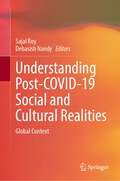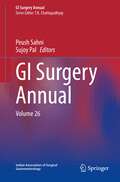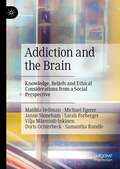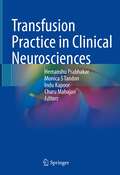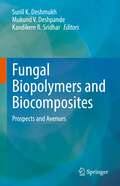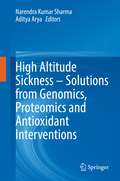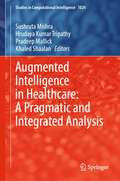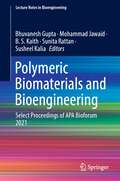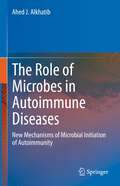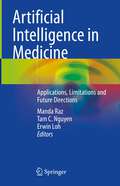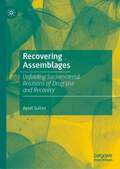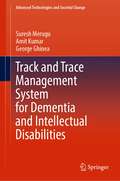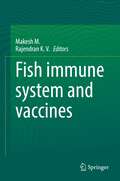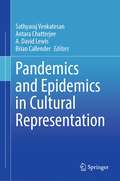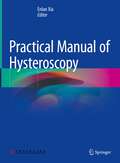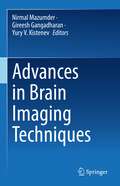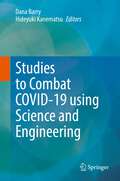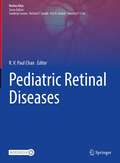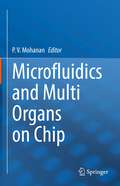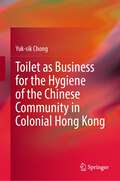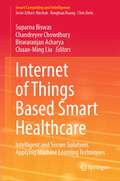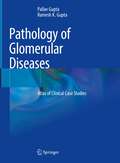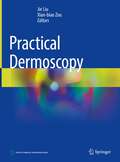- Table View
- List View
Understanding Post-COVID-19 Social and Cultural Realities: Global Context
by Sajal Roy Debasish NandyThis book concentrates on the changing patterns of work and global social order as a result of COVID-19. It scrutinizes these changes in order to point out the possible reasons for these changes following COVID-19. It sheds light on the differences between the condition of underdeveloped and developed countries, focusing on how they struggle to find ways of coping. The pandemic has changed the global social order. It has an impact on every aspect of life around the globe, from individual relationships to institutional operations and international collaborations. Societies are endeavoring to protect themselves despite severe restrictions, while the pandemic continues to upset family relations and overturn governance. COVID-19 has made it clearer than ever before that where many strains on the social sector occur, the current global system, with its interconnectedness and vulnerabilities, is under threat. Due to the changing patterns of economic and societal elements caused by COVID-19, further research is urgently needed to analyze these changing trends. The book portrays what work and the global social order will look like in the future. It is essential reading for anyone interested in these changes and the pst-COVID-19 reality.
GI Surgery Annual: Volume 26 (GI Surgery Annual #26)
by T. K. ChattopadhyayThe twenty-sixth volume of GI Surgery Annual includes chapters on current and upcoming topics in gastrointestinal surgery pertaining to cholangiopancreatoscopy, robotic liver resections and transplants, primary familial intrahepatic cholestasis, managing a patient after total pancreatectomy, transplant immunology and immunosuppression as well as the chapter on advances in gastrointestinal surgery. The authors have expertise and excellent academic track record in the relevant subspecialties. Marrying academic excellence with publishing expertise is going to be the new mantra for the present as well as the upcoming issues of GI Surgery Annual.
Nutritional Toxicology
by Lishi ZhangThis book provides a broad overview of the chemicals in food that have the potential to induce adverse health effects. Nutritional Toxicology is an interaction of nutrition, toxicology, biochemistry and food science, etc. Its main research scope involves the effects of nutrients on metabolisms of toxicants and their mechanisms, the interaction of the toxicants and contaminants originated from diet with nutrients and nutrition process, the adverse health outcome of nutrients excess, as well as methodology of research and related food and nutrition regulation process. Also the risk assessment of toxicants and contaminants in foods, and risk benefit assessment of nutrients (dietary supplementation) has become an emerging topic. This book provides novel and provocative insights into the fields of nutrition, food science and toxicology. It also offers a state-of-the-art report on recent discoveries concerning nutritional toxicology and where the field is going. It mainly focuses on advances made over the past 20 years. It will benefit graduate students, researchers and food and nutrition related regulation parties.
Natural Products as Enzyme Inhibitors: An Industrial Perspective
by Vijay L. Maheshwari Ravindra H. PatilThis book provides an overview of the latest developments and future challenges in enzyme inhibitor research. It discusses the general enzyme inhibitory principles and mechanisms in enzyme activity regulation and application of enzyme inhibitors in different areas and sectors. The major areas of applications of enzyme inhibitors covered in this book are human health management, agriculture, food processing and research, which leads to drug discovery or enzyme activity mechanisms. The book also identifies the gaps in the existing knowledge and opens up new research ideas in this important area. Currently, most enzyme inhibitors are reported to inhibit various classes of enzymes. These enzyme inhibitors are the focus of the scientific community because they may answer an increasing array of questions in the research area of biological sciences, including biochemistry, medicine, physiology, pharmacy, agriculture, ecology etc. It also serves as a useful tool in the study of enzyme structures and reaction mechanisms and in the development of technologies in agriculture, food processing, and health management. Chapters in this book cover topics such as plant-derived inhibitors of serine proteases, pancreatic lipase (PL) inhibitors from indigenous medicinal plants, amylase inhibitors and their applications in agriculture and food processing industries and advances in silico techniques used in the study of enzyme inhibitors. The book will serve as a valuable resource for students and researchers in Life Sciences, agriculture, medicine, food processing, and allied industries.
Addiction and the Brain: Knowledge, Beliefs and Ethical Considerations from a Social Perspective
by Matilda Hellman Michael Egerer Janne Stoneham Sarah Forberger Vilja Männistö-Inkinen Doris Ochterbeck Samantha RundleThis book investigates the neuroscientific knowledge on addiction as an epistemic project.
Transfusion Practice in Clinical Neurosciences
by Hemanshu Prabhakar Monica S Tandon Indu Kapoor Charu MahajanFluid management is the basis of all clinical management in neurosurgical patients. This is a complete book on transfusion practice in clinical neurosciences. It covers in detail the fluids and blood transfusion practice, also discussing the role of total parenteral nutrition in relation to neurologic patients. The importance of fluid management clinically can be seen as on one hand it plays a significant role in maintaining the hydration of the patient and on the other provides sufficient relaxation to the brain to facilitate surgery. The use of hyperosmolar therapy is unique to the practice of clinical neurosciences. Certain fluid types such as those containing glucose are detrimental to the brain. Likewise, large fluid shifts and blood loss are often observed during neurosurgical procedures. It is relevant to understand the physiology of blood and blood transfusion. This book covers all of these topics in their true relevance. It also provides an evidence-based practice of fluid administration for all neurologic patients including, pediatric and geriatric. The proposed book will be useful for trainees and clinicians in any field of clinical neurosciences. It would be very useful for residents and fellows pursuing their courses in neuroanesthesia, neurocritical care, neurosurgery, emergency medicine, anesthesia, and critical care. Fellows, Resident doctors, postgraduates, and even undergraduates would be benefited from this book. The book would be a ready-reckoner and useful during the clinical practice of physicians from varied specialties.
Fungal Biopolymers and Biocomposites: Prospects and Avenues
by Sunil K. Deshmukh Mukund V. Deshpande Kandikere R. SridharThe book covers an overview of fungal polymers, fungal mycelial biomass, and their applications besides providing a detailed account of various opportunities. This book also includes information on developments in mycotechnology related to fashion, furnishing, construction, packaging, mycelial-based bricks, construction binder, cementing materials, and so on. Other aspects include the value of chitin, chitosan, hydrophobins, lignocellulosic composites, oil recovery, biosurfactants and bioemulsifiers, nanofibers from pullulan, exopolymeric substances, bioresins, and biocomposites. Additional topics covered in the book include self-healing fungal concrete (which could help to build repairs) and recipe to inhibit fruit body formation, for living fungal biomaterial manufacture. There is no comprehensive book other than – some reviews, which addressed very brief historical developments and preliminary aspects of fungal biopolymers. Written by experts in their field from countries like Australia, India, USA, Germany, Turkey, Philippines, Oman, Belgium, Italy, Egypt, Brazil, and the United Kingdom, the chapters discuss at length applications of filamentous fungi in sustainable industrial pursuits and industrial developments with environmental safety. This book will be useful for students, teachers, researchers, and scientists in botany, microbiology, life sciences, biotechnology, agriculture and, industries that extensively use fungi for the production of value-added products.
High Altitude Sickness – Solutions from Genomics, Proteomics and Antioxidant Interventions
by Narendra Kumar Sharma Aditya AryaThis book reviews the recent advances in the development of proteomics-based biomarkers for the non-invasive diagnosis of altitude sickness and explores the potential of antioxidant therapy for this sickness. The first chapters introduce the associated pathophysiology and provide mechanistic insights into the enhanced generation of reactive oxygen and nitrogen species (RONS), which leads to an increase in oxidative damage to lipids, proteins, and DNA. The book then highlights the current problems relating to the diagnosis and treatment of altitude sickness and summarizes novel approaches for identifying potential biomarkers and therapeutics. Lastly, it explores the therapeutic efficacy of antioxidant agents.
Augmented Intelligence in Healthcare: A Pragmatic and Integrated Analysis (Studies in Computational Intelligence #1024)
by Sushruta Mishra Hrudaya Kumar Tripathy Pradeep Mallick Khaled ShaalanThe book discusses how augmented intelligence can increase the efficiency and speed of diagnosis in healthcare organizations. The concept of augmented intelligence can reflect the enhanced capabilities of human decision-making in clinical settings when augmented with computation systems and methods. It includes real-life case studies highlighting impact of augmented intelligence in health care. The book offers a guided tour of computational intelligence algorithms, architecture design, and applications of learning in healthcare challenges. It presents a variety of techniques designed to represent, enhance, and empower multi-disciplinary and multi-institutional machine learning research in healthcare informatics. It also presents specific applications of augmented intelligence in health care, and architectural models and frameworks-based augmented solutions.
Polymeric Biomaterials and Bioengineering: Select Proceedings of APA Bioforum 2021 (Lecture Notes in Bioengineering)
by Bhuvanesh Gupta Mohammad Jawaid B. S. Kaith Sunita Rattan Susheel KaliaThis book presents select proceedings of the APA Bioforum International e-Conference on Polymeric Biomaterials & Bioengineering (APA Bioforum 2021). This book mainly focuses on developing innovative polymeric materials for bioengineering and human healthcare systems. This book helps in the understanding of molecular architecture and its role in governing physical characteristics which is extremely useful to understand the interactions with the biosystem. The topics covered include polymer synthesis, biopolymers, biomaterials, smart materials, nanotechnology, tissue engineering, wound care system, hydrogel, targeted drug delivery, water decontamination and purification. The book will be a valuable reference for beginners, researchers and professionals interested in polymeric materials and biomaterials.
The Role of Microbes in Autoimmune Diseases: New Mechanisms of Microbial Initiation of Autoimmunity
by Ahed J. AlkhatibThis book provides a comprehensive, up-to-date review of the state of knowledge on the role of microbes in inducing autoimmune diseases. The initial chapters address the basic concept and clinical implications of immunology, while the following section discusses the role of genetics, epigenetics, hormones, stochastic and environmental factors in the pathogenesis of autoimmunity. The third section introduces readers to various autoimmune disorders and presents the cellular and molecular mechanisms of autoimmune diseases. In closing, the book examines the role of intestinal flora in the development of autoimmune diseases, delineates the underlying mechanism responsible for autoimmunity onset, and examines the potential of microbial therapeutics in the prevention and treatment of autoimmune diseases. Given its scope, the book offers a valuable asset for all scientists and clinicians working in immunology, rheumatology and autoimmune diseases.
Artificial Intelligence in Medicine: Applications, Limitations and Future Directions
by Manda Raz Tam C. Nguyen Erwin LohThis book identifies Artificial Intelligence (AI) as a growing field that is being incorporated into many aspects of human life, including healthcare practice and delivery. The precision, automation, and potential of AI brings multiple benefits to the way disease is diagnosed, investigated and treated. Currently, there is a lack of any appreciable understanding of AI and this book provides detailed understandings, which include; foundational concepts, current applications, future challenges amongst most healthcare practitioners. The book is divided into four sections: basic concepts, current applications, limitations and future directions. Each section is comprised of chapters written by expert academics, researchers and practitioners at the intersection between AI and medicine. The purpose of the book is to promote AI literacy as an important component of modern medical practice. This book is suited for all readers as it requires no previous knowledge, it walks non-technical clinicians through the complex ideas and concepts in an easy to understand manner.
Recovering Assemblages: Unfolding Sociomaterial Relations of Drug Use and Recovery
by Aysel SultanRecovering Assemblages offers an exciting new insight into the policies and practices of recovery and drug use bridging critical drug studies and the sociology of health and illness. The book investigates lived experiences of young people in Azerbaijan and Germany during their personal recovery from alcohol and other drug use and shows the contingency of 'real' experiences. The sociomaterial and ontological analyses unfold the interrelation of practices, spaces, bodies, and affects in experiencing recovery both within and outside of various treatment facilities. The book will appeal to a range of scholars, postgraduates, and undergraduates engaged in critical, methodological, and empirical studies of recovery, drug use, and policy.
Track and Trace Management System for Dementia and Intellectual Disabilities (Advanced Technologies and Societal Change)
by Suresh Merugu Amit Kumar George GhineaThis book reviews humanitarian literature and presents the development of low-cost track & trace management system integrated with accurate GPS location data pinging using Internet of Things (IoT). The first part relates to mobile device configuration with an embedded GPS and wireless Internet connection to transmit its current location. The second part presents web server implementation and development that receives the data, parses it, and stores it for access over the Internet. The third part discusses the user interface that allows one to visually identify the current location of the device.
Fish immune system and vaccines
by M. Makesh K. V. RajendranThis book is a collection of comprehensive and latest information on all aspects of vaccination in fish and shellfish. It provides the basic understanding about the immune system of both fish and crustaceans, besides giving the latest information on adjuvants, vaccine delivery methods, adverse effects of vaccines and methods to assess the efficacy of vaccines. Separate chapters on the role of pattern recognition receptors and interferons in fish vaccination, biofilm vaccines and biosafety and regulatory requirements for fish vaccines are also included. Aquaculture, being the fastest growing food producing industry in the world, is looked upon for alleviating the malnutrition especially among the under privileged population. However, intensive aquaculture practices have led to increased incidences of diseases and significant production losses. Among various health management measures employed in aquaculture, vaccination has been proven to be the best approach to protect fish against pathogens. It is considered to be safe and is a key factor for sustainable aquaculture. In this background, apart from the basic understanding of fish and shellfish immune system, updated knowledge on various types of vaccines and the vaccination strategies currently employed in aquaculture are also covered. The book is designed to provide the latest and comprehensive knowledge on all these aspects as a compiled resource material which is useful to students, researchers and other professionals in the field of aquaculture.
Pandemics and Epidemics in Cultural Representation
by Sathyaraj Venkatesan Antara Chatterjee A. David Lewis Brian CallenderThis edited book analyses how artists, authors, and cultural practitioners have responded to and represented episodes of epidemics/pandemics through history. Covering a broad range of notable epidemics/pandemics (black death, cholera, Influenza, AIDS, Ebola, COVID-19), the chapters examine the cultural representations of epidemics and pandemics in different contexts, periods, languages, media, and genres. Interdisciplinary in nature and drawing on perspectives from medicine, literature, medical anthropology, philosophy of medicine, and cultural theory, the book investigates and emphasizes the urgent need to reflect on past catastrophes caused by such outbreaks. By delving into cultural history, it re-examines how societies and communities have responded in the past to species-threatening epidemics/pandemics. Sure to be of interest to lay readers as well as students and researchers, this work situates epidemics and pandemics outbreaks within the contexts of culture and narrative, and their complex and layered representation, commenting on intersections of contagion, culture, and community. It offers a cross-cultural, global, and comparative analysis of the trajectories, histories and responses to various epidemics/pandemics that impacted people worldwide.
Practical Manual of Hysteroscopy
by Enlan XiaThis book aims to provide readers with the latest information on application of hysteroscopy in diagnosis and treatment of gynaecological diseases. The first chapters systematically review current status, equipment and instruments, applied anatomy, preoperative treatment and anesthesia for hysteroscopic surgery. In the following chapters, details in aspect of hysteroscopy from diagnostic to hysteroscopic surgery are explained with clinical cases. After that, advanced techniques in hysteroscopy combined with laparoscopy and ultrasound monitoring hysteroscopic surgery are introduced with high-resolution illustrations. Written by experts with wealthy experience in the field, this book will be a valuable reference for gynecologists at hysteroscopy units, reproductive units, gynecological and oncological units.
Advances in Brain Imaging Techniques
by Nirmal Mazumder Gireesh Gangadharan Yury V. KistenevThe book reviews the recent developments in brain imaging and their technological advancements to understand molecular mechanisms associated with neurological disorders and basic behaviors in humans and rodents at the structural, molecular, and functional levels. It discusses the usefulness of advanced optical microscopy techniques, including optical coherence tomography (OCT), miniscope, multiphoton fluorescence (2PF & 3PF), adaptive optics, harmonic generation, and Raman microscopy for understanding pathomechanism of brain disorders and pathological and physiological changes associated with neurodegenerative diseases. Also, the book presents conventional imaging modalities, including Magnetic Resonance Imaging (MRI), for delineating underlying mechanisms and precise early diagnosis of neurological disorders. This book is a useful resource for neuroscientists and researchers working in biomedical engineering and optics.
Studies to Combat COVID-19 using Science and Engineering
by Dana Barry Hideyuki KanematsuThis unique book provides excellent examples of ongoing, leading-edge research related to viruses, especially COVID-19. It is written from the viewpoint of various scientific fields including materials science. It introduces and describes viruses (submicroscopic infectious agents that replicate inside the living cells of an organism), various infections caused by viruses (human to human, human to other organisms to humans, humans to materials to humans, etc.), not only from the viewpoint of medical research but also from other scientific disciplines. A major focus of the book is the COVID-19 virus. Highlighted topics include the evolution of COVID-19, transmission of virus particles through the air, virus spread through various materials, detection of the virus by testing wastewater, the development and testing of vaccines and therapeutic drugs, and the preparation for future viruses and pandemics. This includes reform in funeral services to properly and safely accommodate very large numbers of bodies in a pandemic, like those seen in New York City when it was the epicenter for the virus in the United States. This book serves as an excellent and very informative guide (practical book) for engineers and researchers of various backgrounds and as a great academic textbook.
Pediatric Retinal Diseases (Retina Atlas)
by R. V. Paul ChanThis volume on pediatric retina covers all aspects of pediatric retinal diseases as their understanding, diagnosis and management is still under evolution and a challenging task. Newer diagnostic and surgical techniques are being developed and are being adapted for better visual outcome in pediatric cases. It comprises of 10 chapters describing the medical and surgical aspects. The text and figures have been provided in a lucid manner to enhance the understanding of the reader. This volume covers OCT angiography for pediatric retinal disease, clinical spectrum of retinopathy of prematurity, which has become an ever increasing burden of disease for the society and needs special attention, anti-VEGF for retinopathy of prematurity, surgical management of retinopathy of prematurity, retinopathy of prematurity: atypical aspects, Coats’ disease, pediatric retinal inflammatory disorders, congenital X-linked retinoschisis, familial exudative vitreoretinopathy, hematologic disorders: leukemia, hyperviscosity, anemia. It provides descriptions of these disease accompanied by numerous helpful images to highlight these conditions. This atlas will assist the vitreoretinal specialists, general ophthalmologists, retina fellows and post graduate students in successfully identifying the key features of these challenging pediatric vitreoretinopathies. Pediatric Retinal Diseases is one of the nine volumes of the series Retina Atlas. This series provides global perspective on vitreoretinal diseases, covering imaging basics, retinal vascular disease, ocular inflammatory disease, retinal degeneration, surgical retina, ocular oncology, pediatric retina and trauma. Retina Atlas is spread over 9 volumes and about 100 chapters, covering validated and comprehensive information on retinal disorders.
Microfluidics and Multi Organs on Chip
by P. V. MohananThis book highlights the application of microfluidics in cell biology research, chemical biology, and drug discovery. It covers the recent breakthroughs and prospects of organ-on-a-chip, human-on-a-chip, multi-organ-on-a-chip for personalized medicine. The book presents the preclinical studies of organs-on-a-chip, concepts of multiple vascularized organ-on-chips, application of organ-on-a-chip in blood-brain barrier model, culture and co-culture of cells on multi-organ-on-chip and parameter measurements in microfluidic devices. It underscores the advantage of microfluidic devices for developing efficient drug carrier particles, cell-free protein synthesis systems, and rapid techniques for direct drug screening. Further, it entails human-on-a-chip for measuring the systemic response as well as immediate effects of an organ reaction on other organs. In summary, this book reviews the development of a microfluidic-based organ-on-a-chip device for the preclinical evaluation, ADME studies of drugs, chemicals, and medical devices. This book is a valuable source for pharma companies, product developers, students, researchers, academicians, and practitioners.
Toilet as Business for the Hygiene of the Chinese Community in Colonial Hong Kong
by Yuk-sik ChongThis book analyses how public toilets were provided by the government and local business in Hong Kong between the 1860s and 1930s through a process that was embedded in class and racial politics. Addressing public toilet provision from a political economy perspective, it focuses on the interplay of the cross-border night soil business between Hong Kong and China’s silk producing area; the silk market between China and Colonial powers; the Hong Kong land market between the colonial government and Chinese business; and how these factors jointly produced a network of toilets in the colony. As the book shows, the commercial viability of toilets created multiple logics and a new moral geography; further, exploring the topic can help us gain a better understanding of how urban governance functioned in colonies and how it intertwined with economic contingencies within a global economic system. The intended readership includes academics and members of the general public with an interest in colonialism, public infrastructures, public health, government–business relations, and urban governance.
Internet of Things Based Smart Healthcare: Intelligent and Secure Solutions Applying Machine Learning Techniques (Smart Computing and Intelligence)
by Suparna Biswas Chandreyee Chowdhury Biswaranjan Acharya Chuan-Ming LiuThis book provides both the developers and the users with an awareness of the challenges and opportunities of advancements in healthcare paradigm with the application and availability of advanced hardware, software, tools, technique or algorithm development stemming the Internet of Things. The book helps readers to bridge the gap in their three understanding of three major domains and their interconnections: Hardware tested and software APP development for data collection, intelligent protocols for analysis and knowledge extraction. Medical expertise to interpret extracted knowledge towards disease prediction or diagnosis and support. Security experts to ensure data correctness for precise advice. The book provides state-of-the-art overviews by active researchers, technically elaborating healthcare architectures/frameworks, protocols, algorithms, methodologies followed by experimental results and evaluation. Future direction and scope will be precisely documented for interested readers.
Pathology of Glomerular Diseases: Atlas of Clinical Case Studies
by Pallav Gupta Ramesh K. GuptaThis book provides clear understanding of morphological appearances of various glomerular lesions encountered in a wide range of diseases involving renal glomeruli. Chapters cover various diseases with each chapter including a brief text and multiple colored microphotographs depicting the distinctive morphological features of glomeruli as may be encountered in these diseases. It presents complete clinical history with thorough lab workup and other related investigations as considered essential for proper evaluation of the patient. The book provides systemic approach for proper diagnosis of the underlying disease condition in view of the clinical workup and renal biopsy assessment. It provides visual understanding of the glomerular pathology that helps the consultant nephrologist to have a clear understanding of underlying renal disease thus helping in proper evaluation and appropriate therapeutic management of the patient. It may also guide to predict the likely prognostic outcome of the patient. This book is not only helpful to renal pathologists and nephrologists but also serves as a valuable resource for clear understanding of the glomerular lesions to the beginners and postgraduates in nephrology and renal pathology and other physicians managing the patients of renal diseases
Practical Dermoscopy
by Jie Liu Xian-biao ZouThis book aims to provide readers with practical information on the procedure of streamline skin disease recognition with the use of dermoscopy. The first three chapters are mainly focused on the basic knowledge of dermoscopy, such as its history, how it works, the terminology. In the following chapters, the clinical photographs, dermoscopic images and histopathologic images of benign melanocytic neoplasms, malignant melanoma, basal cell carcinoma, seborrheic keratosis and related diseases, vascular diseases, squamous cell neoplasms and other neoplasms are presented in a case-based format. The clinical characteristics are introduced briefly, and the dermoscopic features are highlighted with a number of pictures. The chapter 12 to chapter 14 introduce the dermoscopic appearance of inflammatory skin diseases, infectious and parasitic skin diseases, hair and nail diseases, respectively, which is the extended application of dermoscopy. Last but not least, the development and future of articifial intellegence assisted diagnosis based on dermoscopic images is introduced. Written by dermatologists who have been involved in dermoscopic diagnosis for a long time, this case-based book will be a valuable reference for dermatologists and those who are interested in related field.
